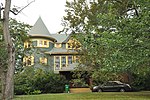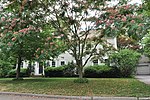Ware Paper Mill
Buildings and structures in Newton, MassachusettsIndustrial buildings and structures on the National Register of Historic Places in MassachusettsNational Register of Historic Places in Newton, MassachusettsNewton, Massachusetts Registered Historic Place stubs

The Ware Paper Mill is a historic mill building at 2276 Washington Street in Newton, Massachusetts. Built in 1790, it is a remnant of the first paper mill to be built on the banks of the Charles River. The 1+1⁄2-story stone building was built by John Ware, a veteran of the American Revolutionary War, and was in use for paper production until 1938. A brick addition was added to the rear of the building in the 19th century; its interior was effectively stripped in the 1973.The building was listed on the National Register of Historic Places in 1978.
Excerpt from the Wikipedia article Ware Paper Mill (License: CC BY-SA 3.0, Authors, Images).Ware Paper Mill
Washington Street, Newton Newton Lower Falls
Geographical coordinates (GPS) Address Nearby Places Show on map
Geographical coordinates (GPS)
| Latitude | Longitude |
|---|---|
| N 42.325833333333 ° | E -71.255277777778 ° |
Address
Washington Street 2282;2284
02462 Newton, Newton Lower Falls
Massachusetts, United States
Open on Google Maps











